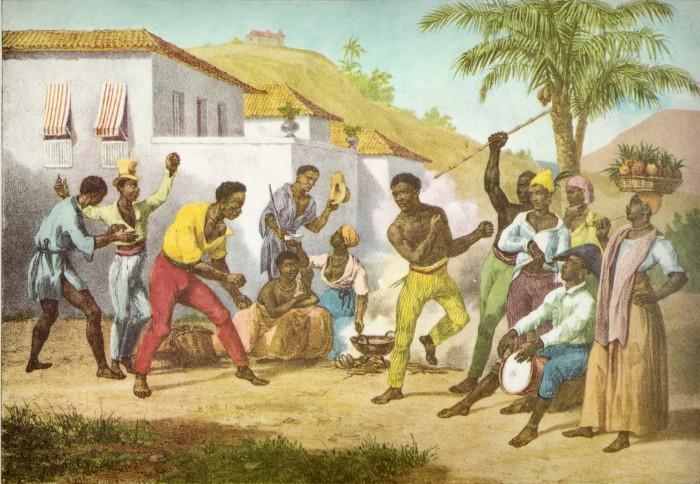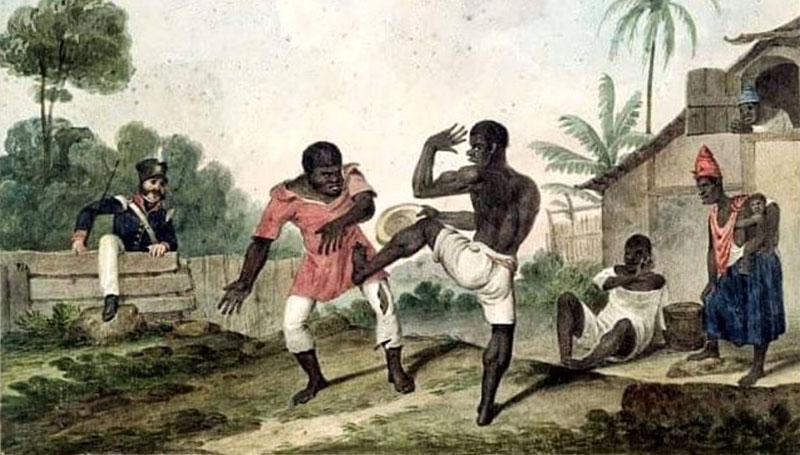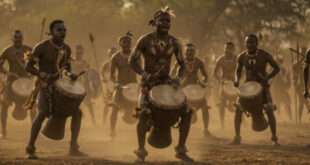The once-forbidden art of slaves defending themselves against their owners is now respected, cherished, and ingrained in Brazilian society. Capoeira is a self-defense and performance martial art that mainly emphasizes kicking and complicated movements from the realms of acrobatics and dance.
Capoeira is a Brazilian martial art that integrates aspects of fighting, music, and dance from Central-West African, Brazilian, and Portuguese traditions. Capoeira is distinguished from other martial arts by the fusion of several cultures from around the world.
Capoeira was an important tool for African slaves to break free from their captors. Today, it is a sport that is performed all over the world, having progressed from obscurity to being highly acknowledged by the fighting community.
Origins of Capoeira

The nobles of the Kongo Kingdom, an independent state ranging from the contemporary states of Congo-Kinshasa and Angola, enjoyed a mutual friendship with Portuguese colonists in the 1500s. Thousands of native peoples were enslaved by the Portuguese in the Kongo Kingdom’s tributary kingdoms, while Kongolese nobles were granted scientific and military aid.
Slaves were transported from Africa to Brazil via the Atlantic Slave Trade, bringing their traditions and cultures with them. Engolo (also known as N’Golo) was a form of Angolan ceremonial warfare that was practiced by a variety of ethnic groups. The origins and practice of Engolo are unknown, although it is thought to be a rite in which young men fight for a possible bride.
Because of the strong use of kicks, sweeps, and the prohibition of hand striking, the combat style is thought to be influenced and adapted from the way Zebras and other animals battled. Engolo is thought to be the forerunner of Capoeira, as it was brought and preserved by Angolan slaves when they crossed the Atlantic to the New World.
Capoeira, on the other hand, is thought to be a uniquely Brazilian art form established and practiced by slaves, rather than an African tradition. According to tradition, hand hitting was prohibited in Capoeira because slaves were unable to utilize their hands due to chains and shackles. However, there is less historical evidence to support this claim.
In the New World
During its early years, Brazil’s economy was geared solely around basic subsistence. Work was required in addition to the enormous region that the Portuguese controlled in order for the economy to thrive. Capture and enslavement of Africans was their solution, as it was for their European counterparts. According to some estimates, approximately 40% of slaves transported from Africa via the Atlantic Slave Trade were sent to work in Brazil.
The Portuguese were a key player in sugar cane production and delivery. Slaves from Africa were sent to labor on plantations to produce and harvest the plant, greatly benefiting the economy. However, they lived in appalling conditions and were defenseless against their owners’ ruthless abuse.
Slaves were unable or unsuccessful in revolting against their owners in a strange location with no weapons and the inability to communicate with other exiled peoples. However, some plantation workers escaped and fled into the country’s forests. To hide from the Portuguese colonists, the fugitives and freed slaves constructed villages high on mountains and deep in the woods. Quilombos were the name for these communities.
Hundreds of Quilombos were built throughout Brazil, with the majority of the slaves being of African heritage. Some Quilombos, on the other hand, incorporated mixed-race and native Brazilian peoples into their newly established villages. Quilombos stayed near tiny colonial communities, towns, and even cities despite being constructed in isolated places because they were not totally self-sufficient. Quilombos’ existence was based on scavenging and stealing food, animals, and freeing other slaves to join their villages.
Quilombos were responsible for numerous attacks and invasions against colonial communities, and the Portuguese sought to conquer and destroy these settlements on numerous occasions. To capture any escapees and destroy the Quilombo settlements, many soldiers, bounty hunters, indigenous, and even slaves were dispatched. The Portuguese, on the other hand, found it tough due to geography and the Quilombo warriors’ “abnormally moving battle tactics.”
Capoeira was introduced and taught to additional slaves in cities as a form of self-defense against their masters. Capoeira was attempted to be banned and prohibited by the Portuguese, with individuals who failed to comply facing severe physical punishment. Many slaves performed the art with each other under the guise of dance to avoid punishment.
Criminals recruited capoeiristas (capoeira specialists) to carry out their crimes after slavery was abolished in 1888. Capoeira was outlawed in Brazil because of the danger it posed to the authorities. Despite the ban, Capoeira was secretly practiced. However, the sport’s rules loosened over time, and it was once again practiced in public.
Capoeira was not officially legalized in Brazil until 1940.
Slaves used to use the popular martial art to defend and free themselves from oppression. It has been passed down down the centuries, and it is now employed for self-defense and enjoyment in the twenty-first century. Despite its past, the Brazilian people regard capoeira as a sacred tradition.
 The African History Truly African
The African History Truly African

